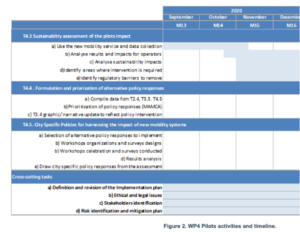Description
The first phase, or “preparing phase”, provides pilots with guidelines for implementing demonstration projects. The evaluation framework compiled by the SPROUT partners guides the set-up of pilot projects.
The SPROUT evaluation framework comprises the use case description, the implementation plan, legal and ethical issues and the involvement of stakeholders. The preparing phase also defines the methodologies and indicators for assessing the financial, (macro-)economic, environmental, and social costs and benefits of the pilot project.
- Use case description: Pilots will give more details to describe their context. Below is a list of information pilots could provide to enrich their descriptions.
-
- Description of the urban mobility solution and its introduction;
- Details about the pilot project implementation area (e.g., location, population, population density, commercial activities, residence area, public transport service level);
- The rationale for selecting the location for implementing the pilot;
- The urban and national level policy framework may affect the pilot implementation positively and negatively.
- The Implementation Plan defines all activities for implementation, data collection, monitoring and evaluation. In addition, the plan specifies the timeline to run the tests, compile data, and analyse the results. Activities are divided into tasks and sub-tasks to allow for defining the responsibilities for carrying out the respective steps. The Figure below shows a generic diagram with minimal activities that pilots may use and adapt.
- Demonstration and pilot projects that collect and use personal data need to consider legal and ethical issues. Those concern the voluntary participation, transparency and adequate information of all participants in the project. Declarations on legal and ethical issues outline data privacy and protection activities, the special attention requirements of vulnerable groups and gender issues, and how users with different cultural backgrounds are considered. More information on legal and ethical issues in the SPROUT pilots is available in the Pilot Evaluation Framework (D1.4), chapter 3.1.1.
- This phase covers the identification of stakeholders involved in the pilots and the planning of their involvement. Stakeholder involvement uses various formats, including workshops, focus groups, site visits, interviews, or surveys. An indicative list of stakeholders has been compiled under SPROUT and is made available in the toolbox.
- This stage also defines the pilots’ indicators during the “using” and “analysis” phases. The indicators will cover the main aspects critical for the feasibility, persistence (durability), and desirability of a new mobility solution in the local context, both for the operator and the society. The chapter “Use Phase and Data collection” below elaborates on the indicators used in the SPROUT project.
Finally, the evaluation framework also provides a multicriteria analysis decision method to identify adequate policy, covering different stakeholders’ preferences and objectives. The SPROUT project used a Multiactor Multi-Criteria Analysis (MAMCA) approach. The adapted MAMCA framework is explained and detailed in the chapter “Analysis Phase.”
SPROUT materials and tools
Other relavent tools and methods
Data required
This step builds upon stakeholder knowledge.
Further Information
This chapter is an adaptation of SPROUT Deliverable D4.14: Pilot evaluation framework, authored by Beatriz Royo (ZLC) et al.


